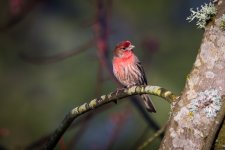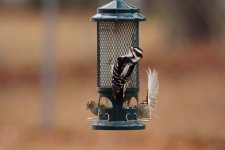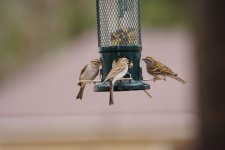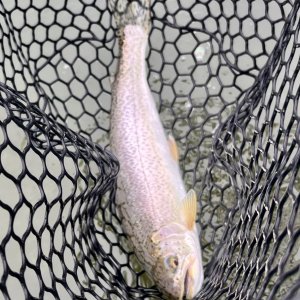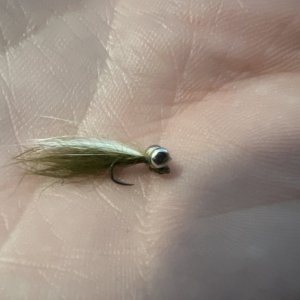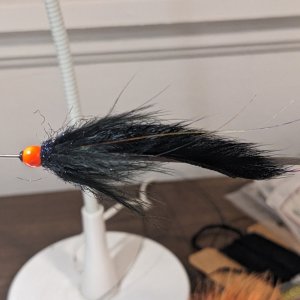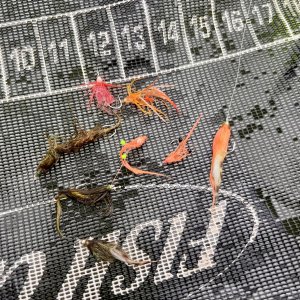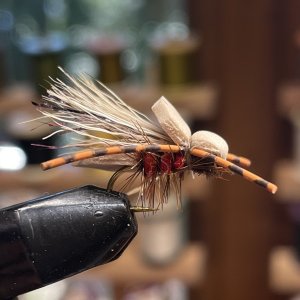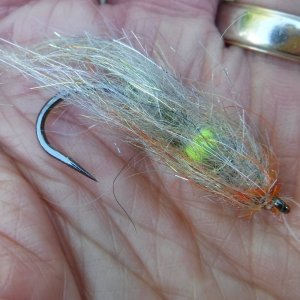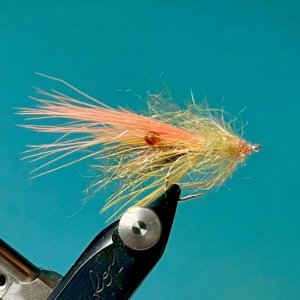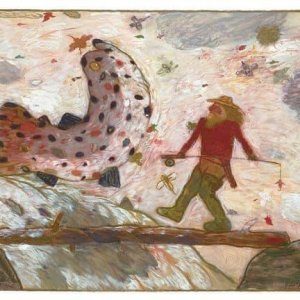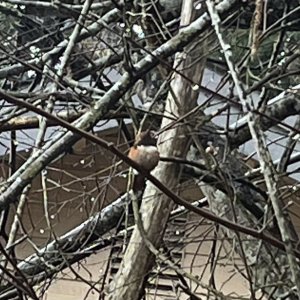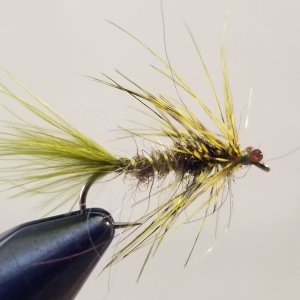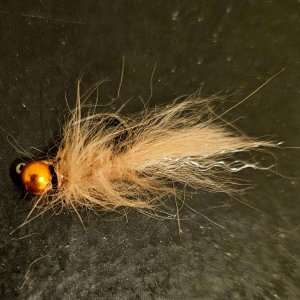You are using an out of date browser. It may not display this or other websites correctly.
You should upgrade or use an alternative browser.
You should upgrade or use an alternative browser.
Got any bird pics?
- Thread starter Wadin' Boot
- Start date
Gyrfalcon22
Life of the Party
Rare blue skies late January. Been suprisingly pretty slow on the coast. The upcoming rain might liven things up as we drag into early Spring.
Graceful Pintail are hard to beat for elegant lines. Bufflehead design patterns are amazing when they swerve in to land.
Mirrored Pintail drakes.
Our local Trumpeter swans- the 4th heaviest flying bird in the world, after 3 species of bustards from far away continents.. Pretty cool and always impressive to see up close. HUGE creatures.
Graceful Pintail are hard to beat for elegant lines. Bufflehead design patterns are amazing when they swerve in to land.
Mirrored Pintail drakes.
Our local Trumpeter swans- the 4th heaviest flying bird in the world, after 3 species of bustards from far away continents.. Pretty cool and always impressive to see up close. HUGE creatures.
Last edited:
Very nice shots of birds in flight!!
[Part 1 of 3]. The forecast called for cloudy skies but no rain but we ended up with intermittent showers as we headed to the coast for some birding. After exploring Ocean Shores and the Grays Harbor National Wildlife Refuge, we drove to Westport, always a favorite birding area. As we walked down float 20 at the Westport Marina, other birders were leaving and they mentioned that there was a yellow-billed loon in the basin. This species breeds in the high Arctic and winters typically off Alaska or British Columbia. So, this would be a rare bird for Washington. After some perseverance, we did manage to see it far off from us in the channel by the fuel dock off Westhaven Dr. But on our way back from the end of the Fisherman’s Board Walk, it had swum closer to the main channel between Float 20 and the other docks. So, we had several very good looks.
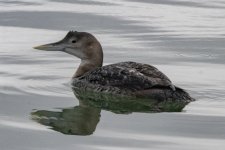
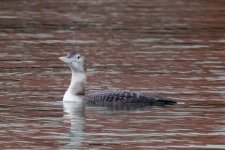
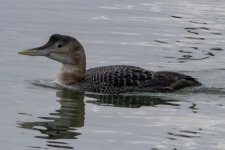
And at one point, the yellow-billed loon cruised over to where a non-breeding common loon had been diving. This offered the opportunity for a nice comparison of the two species. Yellow-billed loons are slightly larger and more lightly marked on the head and neck than are common loons.
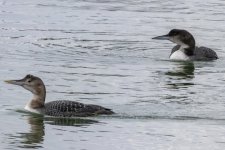
There were many common loons cruising in the boat basin. One bird was very successful in finding clams buried in the mud. And in one picture, you can see the bulge in the bird’s neck where it swallows the clam whole.
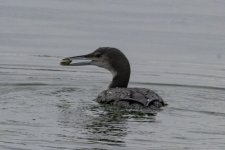
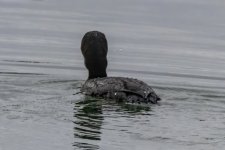
Another bird was diving quite close to Float 20 and I managed to be at the end of one of the slips, partially hidden by a piling when it surfaced. It was unperturbed by my presence and I had the opportunity to snap several close pictures before it resumed diving.
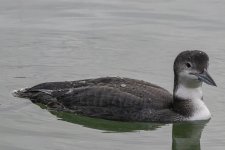
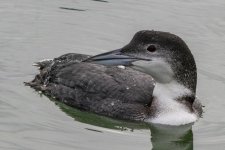
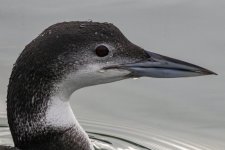
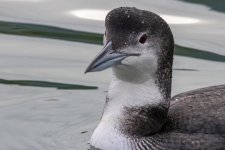
Steve



And at one point, the yellow-billed loon cruised over to where a non-breeding common loon had been diving. This offered the opportunity for a nice comparison of the two species. Yellow-billed loons are slightly larger and more lightly marked on the head and neck than are common loons.

There were many common loons cruising in the boat basin. One bird was very successful in finding clams buried in the mud. And in one picture, you can see the bulge in the bird’s neck where it swallows the clam whole.


Another bird was diving quite close to Float 20 and I managed to be at the end of one of the slips, partially hidden by a piling when it surfaced. It was unperturbed by my presence and I had the opportunity to snap several close pictures before it resumed diving.




Steve
More great pictures - THANKS!
Very nice on the yellow billed!
Very nice on the yellow billed!
[Part 2 of 3]. There were several diving birds working in the waters between float 20 and the outer breakwater. Several cute horned grebes were diving around the empty slips. Some of these birds had vividly red eyes. A number of bird species have red eyes from a number of evolutionary lineages, such as coots, red-eyed vireos, canvasback or wood ducks, zebra finches, and bronzed cowbirds. In some acute cases, red eye is a sign of an eye infection. But in other species, red irises may be caused by the presence of red pigments (especially carotenoids), the diffraction of light, or the reflection of light off hemoglobin in the iris. In some species, eye color changes as the bird ages and between the breeding and non-breeding season. These changes may reflect intraspecific signaling.
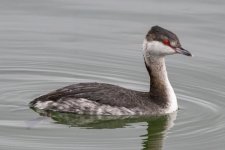
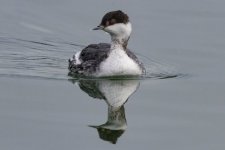
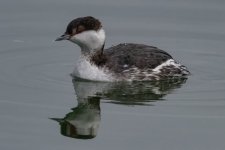
In the main basin, we saw several red-eyed Western grebes diving too.
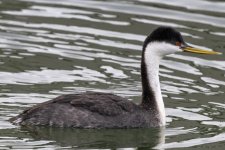
I caught a great picture of a double-crested cormorant during a brief sun break.
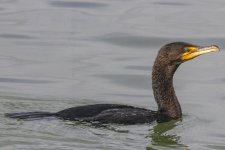
And the Westport boat basin is a great place to see pelagic cormorants as well.
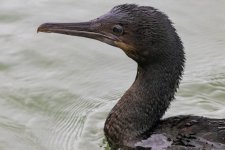
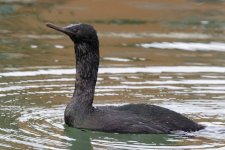
Steve



In the main basin, we saw several red-eyed Western grebes diving too.

I caught a great picture of a double-crested cormorant during a brief sun break.

And the Westport boat basin is a great place to see pelagic cormorants as well.


Steve
Last edited:
Gyrfalcon22
Life of the Party
More nice work, Steve! Grebes are super cool birds. Heck, all red-eyed birds are really cool. I also think of the White-tailed kite and Black crowned Night Herons as more examples of birds we see not too often in this state with stunning red eyes.. (am curious to see if installment 3 has a Common crane sighting on the trip home from the beach?)
[Part 3 of 3] This final section is a mixed bag of pictures from a long, successful day of birding. We started out at Ocean Shores, but with a King high tide, rough seas, and an intermittent drizzle, we didn’t have much success. We made the executive decision to drive around the bay to Westport. On our way, we stopped at the ponds by the Hoquiam Sewage Treatment plant by the Hoquiam airport and the Grays Harbor Wildlife Refuge. As expected, the ponds were filled with ducks: mallards, gadwalls, ring-necked ducks, and buffleheads. A small flock of Canada geese were grazing in the grass. Among them was a single cackling goose, the Mini-Me to the Canada geese. Cackling geese top the scales at 3.5 lbs. while Canada geese top out at 9.8 lbs.
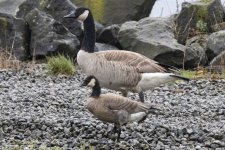
Just east of the ponds is a partially-flooded pit. A flock of western sandpipers snoozed along the shore as they waited for the tide to drop and the mud flats to be exposed.
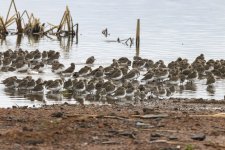
A single long-billed curlew mixed in with a group of ring-billed gulls. This species breeds in the Great Basin and Great Plains and typically winters from the coast of California into Mexico and Central America, along the Gulf Coast, and around Florida as far north as North Carolina. I have seen this species previously in Southern California, but this was a new species for me to see in Western Washington.
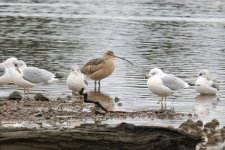
In the boat basin at Westport, several red-breasted merganser hens foraged for lunch. This picture nicely highlights the difference between this species and common mergansers. Red-breasted merganser hens have a double-crest of long reddish-brown feathers off the back of the head (versus a shorter crest in common mergansers). And the chin and throat of red-breasted mergansers have a pale chin and neck (versus the white chin patch and white neck of common mergansers. Also, red-breasted mergansers tends to be found in marine habitats while common mergansers prefer freshwater habitats.
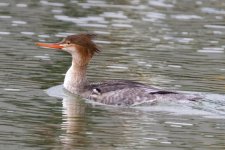
On our way back home from the coast, we drove down the Brady Loop Road into @Gryfalcon’s stomping grounds. We did not have high hopes that we would find the common crane that has been seen in that area with a flock of sandhill cranes. It appears that the flock had moved off. And we didn’t see the immature golden eagle whose excellent pictures @Gryfalcon has shared with us. But we did see some bald eagles off in the trees.
But we did have great views of trumpeter swans. A family group was dabbling in a flooded field.
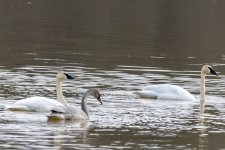
We encountered a larger flocking a field by the road. These were pretty calm as we drove closer and I squeezed off a series of pictures from my driver’s side window. They are the largest native waterfowl, tipping the scales at more than 25 pounds. Populations of this species have been increasing on recent years and expanding their range.
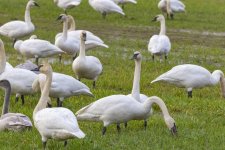
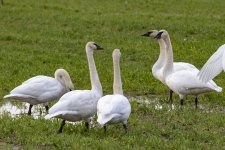
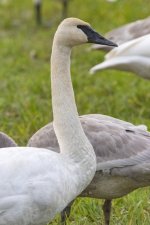
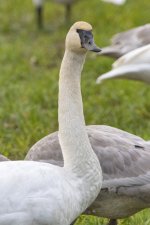
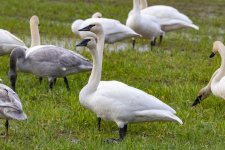
Steve

Just east of the ponds is a partially-flooded pit. A flock of western sandpipers snoozed along the shore as they waited for the tide to drop and the mud flats to be exposed.

A single long-billed curlew mixed in with a group of ring-billed gulls. This species breeds in the Great Basin and Great Plains and typically winters from the coast of California into Mexico and Central America, along the Gulf Coast, and around Florida as far north as North Carolina. I have seen this species previously in Southern California, but this was a new species for me to see in Western Washington.

In the boat basin at Westport, several red-breasted merganser hens foraged for lunch. This picture nicely highlights the difference between this species and common mergansers. Red-breasted merganser hens have a double-crest of long reddish-brown feathers off the back of the head (versus a shorter crest in common mergansers). And the chin and throat of red-breasted mergansers have a pale chin and neck (versus the white chin patch and white neck of common mergansers. Also, red-breasted mergansers tends to be found in marine habitats while common mergansers prefer freshwater habitats.

On our way back home from the coast, we drove down the Brady Loop Road into @Gryfalcon’s stomping grounds. We did not have high hopes that we would find the common crane that has been seen in that area with a flock of sandhill cranes. It appears that the flock had moved off. And we didn’t see the immature golden eagle whose excellent pictures @Gryfalcon has shared with us. But we did see some bald eagles off in the trees.
But we did have great views of trumpeter swans. A family group was dabbling in a flooded field.

We encountered a larger flocking a field by the road. These were pretty calm as we drove closer and I squeezed off a series of pictures from my driver’s side window. They are the largest native waterfowl, tipping the scales at more than 25 pounds. Populations of this species have been increasing on recent years and expanding their range.





Steve
Last edited:
Gyrfalcon22
Life of the Party
What a great day of birding, Steve! Well detailed documentation as always, your work. The Common crane has moved about 8 miles or so east. I visited one time. The road is raised and the steep shoulder off the road is pretty narrow, and the cars are pretty tight zipping by the oddly heavily traveled area (the old nuclear plant road). Not ideal or peaceful. Still keeping pretty far away, have yet to see any shots of the bird within 100 yards, often 200-300+ yards.
Shot below sort of is misleading as to the size differential between the Common and the Sandhill gang.
Shot below sort of is misleading as to the size differential between the Common and the Sandhill gang.
Last edited:
Yes, this picture does make the common crane seem much larger than the sandhills. But the typical measurements of the two species are quite similar.What a great day of birding, Steve! Well detailed documented as always, your work. The Common crane has moved about 8 miles or so east. I visited one time. The road is raised and the steep shoulder off the road is pretty narrow, and the cars are pretty tight zipping by the oddly heavily traveled area (the old nuclear plant road). Not ideal or peaceful. Still keeping pretty far away, have yet to see any shots of the bird within 100 yards, often 200-300+ yards.
Shot below sort of is misleading as to the size differential between the Common and the Sandhill gang.
View attachment 52737
Have you heard any further discussion of whether this bird is a hybrid or a lost wanderer from Eurasia?
Steve
Gyrfalcon22
Life of the Party
The Common has a little more height and bulk when seen fairly, but not a lot of difference as you noted @Cabezon
I read more about people in the know thinking it is a pure Common, and likely an immature female. There are people coming from across the states to see it. I have talked to a few locally that swing this way to see other birds who have seen Commons before worldwide and they seem pretty sure it is a clean genetic bird.
Not sure when they make the call to accept it. Some big meeting somewhere in the future I guess where all the evidence is presented.
This first shot below is about the most accurate size comparison. You can see just the extra bit of length in the legs and the neck build.
An Emu-esque looking bird !
Emu for fun, yet thought provoking comparison
I read more about people in the know thinking it is a pure Common, and likely an immature female. There are people coming from across the states to see it. I have talked to a few locally that swing this way to see other birds who have seen Commons before worldwide and they seem pretty sure it is a clean genetic bird.
Not sure when they make the call to accept it. Some big meeting somewhere in the future I guess where all the evidence is presented.
This first shot below is about the most accurate size comparison. You can see just the extra bit of length in the legs and the neck build.
An Emu-esque looking bird !
Emu for fun, yet thought provoking comparison
Last edited:
Gyrfalcon22
Life of the Party
@Bajema From what I have read (am adding these shots of the Skagit bird off of eBird from a couple years back-not mine), this Skagit bird had much more striking and clear-cut plumage of an adult Common Crane. This year's "coastal" Common is just not far enough different from the looks of known hybrid individuals of a sandhill x common that have been seen in the US before.
A friend of mine had some video yesterday of the local Common and Sandhills hopping and dancing so these birds seem pretty cozy together where one could surmise that interbreeding is a distinct possibility, if not already within this season's coastal bird, but perhaps will be in the upcoming nesting season.
Scientists like @Cabezon will remind us that distinguishing questionable species by "looks" without genetic screening is not good conclusive scientific work, and likely why it has not been called the Real Deal.
Interesting to see how this one plays out for sure !
Skagit Common Crane
A friend of mine had some video yesterday of the local Common and Sandhills hopping and dancing so these birds seem pretty cozy together where one could surmise that interbreeding is a distinct possibility, if not already within this season's coastal bird, but perhaps will be in the upcoming nesting season.
Scientists like @Cabezon will remind us that distinguishing questionable species by "looks" without genetic screening is not good conclusive scientific work, and likely why it has not been called the Real Deal.
Interesting to see how this one plays out for sure !
Skagit Common Crane
Last edited:
I did a brief search for evidence of crane hybrids. One review paper that was published in 1983 indicated that crane hybrids in the wild were fairly rare, but it has occurred in captivity and especially via artificial insemination (see table 27). But a more recent report indicates that multiple cases of hybridization between sandhill cranes and common cranes in the wild have been documented in the last 20 years. This may be the result of escapees of common crane from captivity in North America (paired with a rebound in the number of sandhill cranes in the U.S.).@Bajema From what I have read (am adding these shots of the Skagit bird off of eBird from a couple years back-not mine), this Skagit bird had much more striking and clear-cut plumage of an adult Common Crane. This year's "coastal" Common is just not far enough different from the looks of known hybrid individuals of a sandhill x common that have been seen in the US before.
A friend of mine had some video yesterday of the local Common and Sandhills hopping and dancing so these birds seem pretty cozy together where one could surmise that interbreeding is a distinct possibility, if not already within this season's coastal bird, but perhaps will be in the upcoming nesting season.
Scientists like @Cabezon will remind us that distinguishing questionable species by "looks" without genetic screening is not good conclusive scientific work, and likely why it has not been called the Real Deal.
Interesting to see how this one plays out for sure !
Skagit Common Crane
View attachment 52855
Steve
Gyrfalcon22
Life of the Party
Good stuff, Steve ! Always appreciate your references
I did a brief search for evidence of crane hybrids. One review paper that was published in 1983 indicated that crane hybrids in the wild were fairly rare, but it has occurred in captivity and especially via artificial insemination (see table 27). But a more recent report indicates that multiple cases of hybridization between sandhill cranes and common cranes in the wild have been documented in the last 20 years. This may be the result of escapees of common crane from captivity in North America (paired with a rebound in the number of sandhill cranes in the U.S.).
Steve
Thanks for the info Steve; an interesting history of the flocks in New Jersey:

Old Crooked Toe and the Cranes of Southern New Jersey | New Jersey Audubon
Related Posts Identifying Two Common Garden Caterpillars South Jersey Eco-Schools AwardsVineland High School and Bridgeton Public Charter School both earned bronze Eco-Schools USA awards last… A Fowl February Member Meadowlands Morning Birders’ Bucket List Bash!
 njaudubon.org
njaudubon.org
Cheers
Gyrfalcon22
Life of the Party
The local wild ducks, such as these flashy, small and FAST Green-winged teal, are pretty happy they made it past the closing of the hunting season ! Almost overnight after the last day of the season they show in nice numbers and are already much more calm and within camera range. A couple weeks back you could not get within 200 yards of them on a pond.
Last edited:

